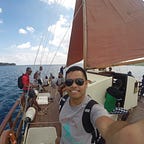A recent study published in Earth’s Future, forecasts that the Marshall Islands (RMI)could become uninhabitable within the next 50 years if adaptive measures are not taken immediately.
The research conducted by a team from the University of Hawaii at Manoa estimate unprecedented rates of anthropogenic sea level rise (ASLR) within the next century.
ASLR is the rise of sea levels because of human impacts on the environment in the form of chemicals or biological wastes.
Coastal geologist and lead author in the research, Haunani Kane says, “some scientists argue that because of their geologic history reef islands could be resilient to human-caused sea-level rise, but most such studies consider islands and their people to be separate entities.”
“We found that as really being disconnected from the way that we live on islands,” she added.
“This study eliminates some of the confusion and the gaps in knowledge related to how sea-level rise will impact low-lying islands because it considers the impacts upon and resilience of both the place and the people.”
The RMI is made up of 29 atolls and 5 mid‐ocean reef platform islands aligned along two nearly parallel chains.
The report states that, “in the most likely scenario, the rate of sea level rise will triple, and groundwater sources will be permanently lost, within only a few decades.”
It goes on to add that under an extreme scenario, the islands will be fully unstable, and “community infrastructure will be at intolerable levels of risk as regional sea level exceeds 1 meter by the year 2060.”
According to a special report published by the Intergovernmental Panel on Climate Change (IPCC) in 2019, “the dominant cause of sea level rise since 1970 is anthropogenic forcing and in the future will be strongly dependent on greenhouse gas emissions.”
In the RMI, high‐end anthropogenic sea level rise (ASLR) projections exceed the average elevation of low islands and threaten the sustainability of fundamental resources like fresh groundwater and soil for cultivation.
Based on the IPCC modelling, the relative sea level rise for RMI by 2100 is 1.1 meters with the average altitude in the Marshalls being just over 1 meter.
According to Senior Research Fellow at the Pacific Centre for Environment and Sustainable Development (PACE-SD) at the University of the South Pacific (USP) in Fiji, Dr. Mahendra Kumar, what this means is that by 2050 up to 50% of the main island, Majuro, which is home to the largest population of Marshallese in RMI will be greatly affected.
He says, “this underscores the need for accelerated adaptation. The need to be able to deal with these sorts of things, to err on the side of caution.”
Dr. Kumar who himself was part of a consultation team to the RMI government adds, “the Marshall Islands has rightly decided that it will base its adaptation through a knowledge-based approach.”
“It will also emphasize the need to talk and consult the very people for who adaptation is being done, the people.”
“It has to involve transformative innovations and technology as well as some of the traditional ways of doing things.”
He believes that immediate problems like coastal protection, food and water security need to be dealt with first.
However, points out that radical adaptation measures need to already be in place in case sea level changes come true and large sections of the country is submerged.
One radical approach to adaptation is presented by Autumn Border, who with others writes in the Global Environmental Change that in‐country migration by raising the elevation of existing islands and the construction of artificial islands could be a possible solution.
Border states that, “Marshallese leaders are committed to adapt in place to protect the sovereignty and identity of their people.”
Dr. Kumar says that, “some of the principles that is going into these plans is one of the fundamental right of countries to exist. It’s their human right to have a country to exist and to not lose their culture.”
“Migration,” he adds, “has its problems; it could be that particular islands are done up, basically elevated through [land] fills, through coastal protection so that they become good enough for people to exist.”
“But this comes at a price. It’s a hugely complex process, particularly for a country like the Marshalls which doesn’t have the fill but it’s something which is being looked at.”
Regarding the adaptation to ASLR, Dr. Kane’s study states that, “the indigenous values embodied in island cultural identity are based on location and grow out of a millennial history of survival as a community.”
“The modern economic and global security values embodied in the sovereign nationhood of atoll republics are similarly based on strategic mid‐ocean location. Such place‐based values eliminate the option of population‐scale migration as a solution to ASLR as it will lead these values to transition from stability to instability.”
She says, “the people of that place have the ultimate authority over the decisions that they think are best.”
Her report concludes, that ASLR impacts are much more than the loss of remote islands.
“ASLR threatens the cultural identity and political sovereignty of island nations.”
“ASLR, like all climate‐related impacts, is a complex physical, social, and dynamic issue that requires adaptable planning methods, transdisciplinary research, and an open‐minded, multiworld view approach that fosters the ensured existence of people’s identity.”
